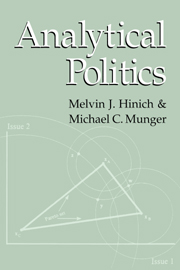Solutions to selected exercises
Published online by Cambridge University Press: 05 June 2012
Summary
CHAPTER 2
2.1 Arrange the positions in order {−2, 2, 6, 9, 9} to see that the median is 6 (there are two points smaller than 6 and two points greater). The mean, or average, is the sum of the above positions divided by the number of positions (five): 24/5.
2.2 By the definition of symmetry, changes in either direction will yield similar changes in a voter's utility. The two voters with positions less than 3 will clearly vote for it, and the two with positions greater than 8 will choose it. The middle voter at position 6 has symmetric preferences, so equal changes in either direction yield equal changes in utility; since 3 is further away than 8, the median voter will choose 8 (closer is better) and 8 will win 3 to 2.
2.3 If 7 is added to the committee, then no unique median exists; 6 and 7 are both medians. If this new committee is asked to choose between 8 and 3, then 8 will again be chosen.
2.4 Order the positions to find the median {−4, −3, 6, 7, 21}. By definition, 6 must be the median. If one replaces 7 with 25 the new ordering is {−4, −3, 6, 21, 25} and the median stays the same. The mean, however, changes (increases).
2.5 Probably not. One can imagine a society in which a few outliers change the mean from the true middle of society.
- Type
- Chapter
- Information
- Analytical Politics , pp. 245 - 248Publisher: Cambridge University PressPrint publication year: 1997

